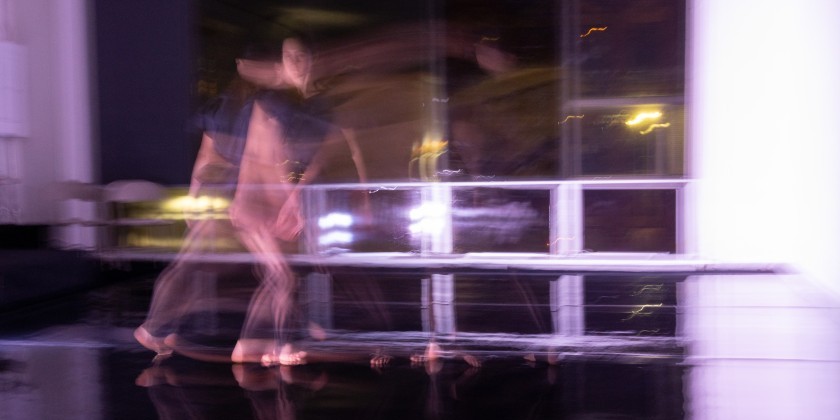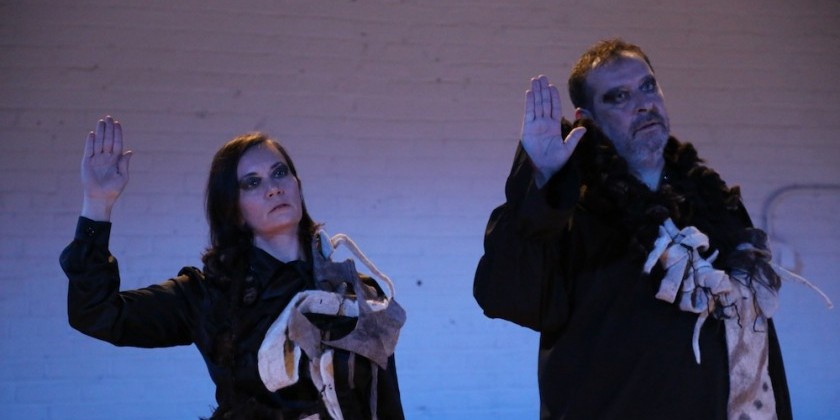IMPRESSIONS: Matthew Lutz-Kinoy's "Filling Station" presented by The Kitchen

Performers: Kris Lee, Ayano Elson, Maxfield Haynes, Niall Jones, Bria Bacon, Niala, Mina Nishimura
Choreography: Niall Jones // Consulting Choreography: Raymond Pinto
Set Design and Libretto: Matthew Lutz-Kinoy
Music: James Ferraro // Costumes: Eckhaus Latta // Rehearsal Documentation Photography: Mary Manning
Video Documentation: Al Foote // Photography Assistant and 2nd Camera Operator: Jeremie Egiazarian
Hair: Sean Michael Bennett // Make-up: Juan Jaar // Program Design: Rob Kulisek and Matthew Lutz-Kinoy
Commissioned by The Kitchen
Performances presented by The Kitchen at Horatio Street Gas Station and co-presented with Dia Art Foundation at Dia Beacon
Exhibition on view at The Kitchen at Westbeth through November 3, 2023. More info.
Filling Station is subtitled “A Ballet-Document in One Act.” This is true of both Lew Christensen's original 1938 dance for Ballet Caravan and Matthew Lutz-Kinoy’s 2023 reworking presented by The Kitchen.
What is a “ballet-document” exactly? The parameters for this rarely-articulated genre seems murky or flexible at best, though Lutz-Kinoy’s project does much to shed light on the ballet-document’s potential to transmit and transform lineage through multidimensional, transdisciplinary acts of embodied movement, creation, and documentation. The dance and its attendant exhibition simultaneously remember, reenact, reimagine, and recreate through a deeply-researched process of renegade stewardship undergirded by a sense of attentive care. The act of care is demonstrated in the contemporary ballet-document’s startling negotiation of reverence and irreverence in the face of a quintessentially American masterwork.
At the time of its creation at the dawn of American ballet, Christensen’s Filling Station was a notable landmark: it was the first ballet choreographed, composed, designed, and danced by American artists on American themes. This articulation of American identity on the nascent American ballet stage would go on to transform the techniques, aesthetics, and imperatives behind American dance and culture more broadly — a process which only continues to unfold as collective senses of nation and national identity face long-overdue scrutiny and undergo concerted reexamination.
Lutz-Kinoy’s Filling Station is at its core a raucous and radical rearticulation of “America” through a queer intersectional lens that reframes power relations along lines of race, class, gender, and sexuality. Depending on one’s social location, this “America” can read as comfortably familiar or intensely alien — visceral sensations that are amplified by the multiple settings in which the project unfolds.

Matthew Lutz-Kinoy's Lew’s blue shadow touches a smokey toilets, 2023, acrylic on canvas. On view until November 3, 2023. Photo by Jason Mandella
The impact of Lutz-Kinoy’s ballet-document lies in its lustrous translucency and mischievous mystique. In addition to three performances across two sites, a multimedia exhibition on view at The Kitchen at Westbeth through November 3 presents a selection of archival photographs, artwork, and ephemera that grounded Lutz-Kinoy’s three-year research and creation process. Reproductions of original costume and set designs and stunning portraits of lead dancers come sharply into focus alongside booklets, magazines, and other media that evidence the fresh, boundary-pushing energy that propelled emergent 20th century American ballet.

Matthew Lutz-Kinoy's Roadside Gas Sign, 2023, acrylic on canvas. Photo by Jason Mandella
Illuminating the archives are Lutz-Kinoy’s large-scale painted canvas backdrops, hung to both partition the exhibition space and lend an atmospheric sense of place to the objects on view. Light from The Kitchen’s south- and west-facing windows along the Hudson spills through the canvases so their colors blaze to life on both sides. Muted browns, greens, and grays sing alongside electric blues and fluorescent orange-reds. Ghostly silhouettes captured in postures of rest and motion hover amidst Filling Station iconography to evoke the dueling intimacies of open road and lonely outpost. In-process sketches, photos, video, and costume elements round out a rich conversation between eras and artifacts, echoes and vestiges. While the exhibition is certainly enlivened by the dance—now itself a remembrance for the archive — it also stands strongly on its own on both sides of the “ballet-document” hyphen.

Maxfield Haynes, Kris Lee, and Niall Jones in Matthew Lutz-Kinoy's Filling Station at a Mobil gas station on 8th Avenue and Horatio Street, New York, September 15, 2023. Photo by Walter Wlodarcyzk
An ethos of placemaking centers both Christensen’s articulation of a modern American pastoral and Lutz-Kinoy’s firm anchoring in a here-and-now that gazes equally forward and backward with an inclusive peripheral sweep. The latter’s choice of place — the iconic Horatio Street gas station in the West Village — functions as a narrative presence that amplifies the human explorations and entanglements of the dance. The place has character, is character, in every unaltered detail of its form, function, and context: bare-bones pump fixtures, brightly colored minimart branding, graffitied back sides of low apartment buildings and blind brick walls that loom above and frame this utilitarian landmark. Gas stations stand as one of the few reliable public arenas for encounters across identity and class boundaries, particularly in an area with heavy pedestrian traffic. By situating the dance in the open space of an operational gas station, the artist amplifies an American placemaking rooted in access, mobility, and opportunity.

Kris Lee, Mina Nishimura, Maxfield Haynes, Ayano Elson, Bria Bacon, and Niala in Matthew Lutz-Kinoy's Filling Station. Photo by Walter Wlodarcyzk
The dance itself unfolds over a series of scenes driven by the vivid, generous characterizations of its pitch-perfect cast and James Ferraro’s lush, melodious score. The cast of characters parallels the original to an extent, retaining Mac the dreamy station attendant (whose translucent white jumpsuit by Eckhaus Latta most closely evokes Paul Cadmus’s original design), Ray and Roy the genial truck drivers, and a menacing Police Officer, while departing from the caricatures of Christensen’s motorist family, gangster, and drunken country club couple in favor of a sloppy Tourist, two harried Activists, and a Rich Girl and her Rich Date. The narrative and choreographic structures and elements likewise echo and riff on the original, always evocative of spirit without resorting to imitation. Each character is defined by a dynamic movement signature that clearly communicates their status and purpose in the physical space and social context, adding texture to the frictions that arise in their encounters.

Kris Lee in Matthew Lutz-Kinoy's Filling Station. Photo by Walter Wlodarcyzk
Kris Lee as Mac anchors the work with bookend solos that lay claim to the space, opening as an invocation and closing as an elegy to transformation. Mac is the quiet center of the story, an unsung working class hero who’s seen it all and sticks around to cleans up the mess. Maxfield Haynes and choreographer Niall Jones add playful charm and urgency to Ray and Roy’s athletically nonchalant antics, tossing in a radiant dose of grace and warmth for good measure. Ayano Elson does double duty, first as a brazenly-littering, disposable camera-wielding Tourist, transforming later into a black-clad, sharp-limbed Police Officer straight out of The Matrix. Mina Nishimura’s Activist explodes onto the scene with disjointed erratics with an unsettling intensity of focus, drawing in and transforming Haynes into her doppelgänger in lockstep. As the rich couple, Bria Bacon and Niala roll in on a Revel moped, the sumptuous textures of their attire and extravagant vernacular placing them in a reified realm that dips briefly into the melee only to sail off again in a jangle of sequins.

Bria Bacon and Niala in Matthew Lutz-Kinoy's Filling Station. Photo by Walter Wlodarcyzk
The capsular social constellations mapped in these interactions give rise to tensions and conflicts that never quite seem to reach resolution, instead flowing blithely back into the constant stream of life. These artists wield their defiant queerness with deftness and dignity, illuminating but never parodying Christensen’s Filling Station Americana. Their joy is palpable as they luxuriate at the precipice of every step to fill the rich curtain of Ferraro’s Copland-esque orchestral swells and percussive drama. They move with an almost unconscious purpose, continually building and inhabiting a world that somehow needs them all. In this Filling Station a new Americana comes to life, one whose frontiers lie continually just beyond the reach of our imaginations.

Maxfield Haynes and Niall Jones in Matthew Lutz-Kinoy's Filling Station. Photo by Walter Wlodarcyzk













